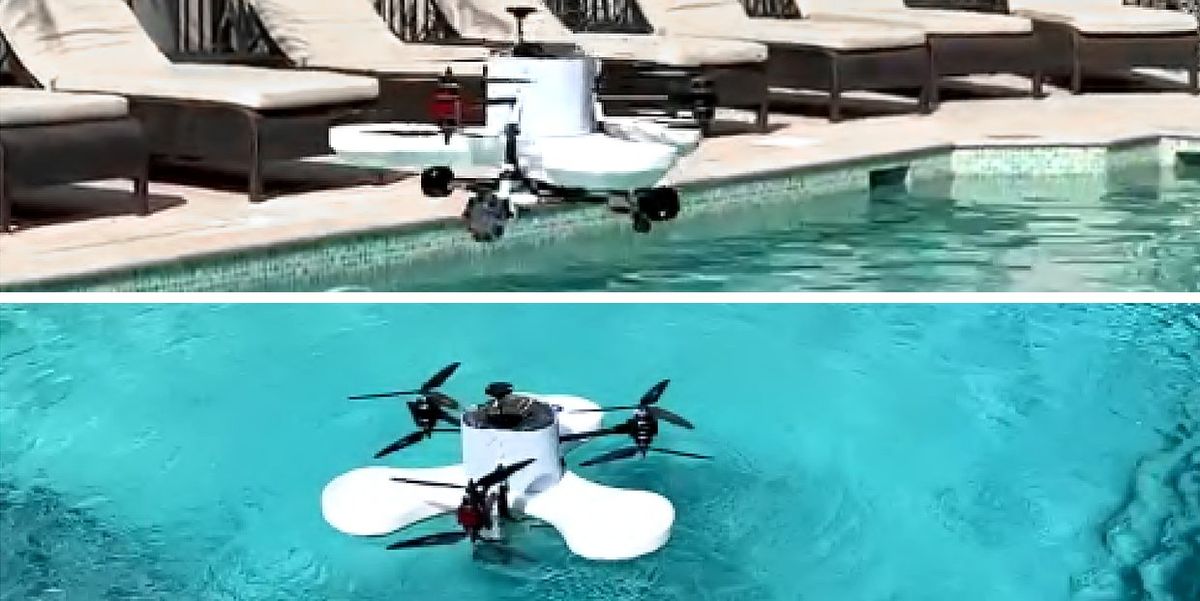This article is part of our exclusive IEEE Journal Watch series in partnership with IEEE Xplore.
Instead of one autonomous robot to fly, another to drive on land and one more to navigate on water, a new hybrid drone can do all three. To carry out complex missions, scientists are increasingly experimenting with drones that can do more than just fly.
The idea for a drone capable of navigating land, air, and sea came when researchers at New York University Abu Dhabi’s Arabian Center for Climate and Environmental Sciences (ACCESS) noted they would like a drone “capable of flying out to potentially remote locations and sampling bodies of water,” says study lead author Dimitrios Chaikalis, a doctoral candidate at NYU Abu Dhabi.
Environmental research often “relies on sample collections from hard-to-reach areas,” Chaikalis says. “Flying vehicles can easily navigate to such areas, while being capable of landing on water and navigating on the surface allows for sampling for long hours with minimal energy consumption before flying back to its base.”
The new autonomous vehicle is a tricopter with three pairs of rotors for flight, three wheels for roaming on land, and two thrusters to help it move on water. The rubber wheels were 3D-printed directly around the body of the main wheel frame, eliminating the need for metal screws and ball bearings, which would run the risk of rust after exposure to water. The entire machine weighs less than 10 kilograms, in order to comply with drone regulations.
A buoyant, machine-cut Styrofoam body was placed between the top of the machine, which holds the rotors, and its bottom, which holds the wheels and thrusters. This flotation device served as the machine’s hull in the water, and was shaped like a trefoil to leave room for the airflow of the rotors.
“The resulting vehicle is capable of traversing every available medium—air, water, ground—meaning you can eventually deploy autonomous vehicles capable of overcoming ever-increasing difficulties and obstacles,” Chaikalis says.
The drone possesses two open-source PX4 autopilot systems: one for the air, and the other for navigating both land and water. “Aerial navigation differs heavily from ground or water surface navigation, which actually bear a lot of similarities with each other,” Chaikalis says. “So we designed the ground and water surface navigation to both work with the same autopilot, changing only the motor output for each case.”
An Intel NUC computer served as the command module. The computer can switch between the two autopilots as needed, as well as interface with a radio transceiver and GPS. All these electronics were secured within a waterproof plastic casing.
“Of course, you also have to get waterproof motors for the ground-vehicle wheels, since they’ll be fully submerged when on water,” Chaikalis says. “Such motors proved difficult to interface with commercial autopilot units, so we ended up also designing custom hardware and firmware for interfacing such communications.”
The drone can operate under radio control or autonomously on preprogrammed missions. Its lithium polymer batteries give it a flight time of 18 minutes.
In experiments, the Styrofoam hull absorbed water during floating, increasing its weight by 20 percent within 30 minutes. The Styrofoam did release this water during flight, albeit slowly, with a 20 percent weight loss after 100 minutes. The scientists note this significant variation in weight needs to be accounted for in the autopilot design, or they could add a water-resistant coating, although that would permanently increase the overall weight.
In addition, “although waterproof against splashes and light submersion, this is not yet a fully submersible design, meaning a failure of the flotation device could potentially be catastrophic,” Chaikalis says.
In the future, the researchers note they could optimize the hull to make it strong enough to withstand complex maneuvers and to minimize air drag during flight. They would also like to make the drone fully modular so they can easily change its capabilities by attaching or detaching modules from it.
“We imagine being capable of, for example, selecting to drop the ground mechanism behind if necessary to save power, then returning to it later to land,” Chaikalis says. “Or allow the water module to navigate on water, while the [unmanned aerial vehicle] returns to a nearby base for recharge and picking it up again later.”
A patent application is pending on the new drone. The scientists detailed their findings 9 June at the 2023 International Conference on Unmanned Aircraft Systems in Warsaw.
Charles Q. Choi is a science reporter who contributes regularly to IEEE Spectrum. He has written for Scientific American, The New York Times, Wired, and Science, among others.



